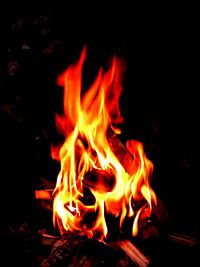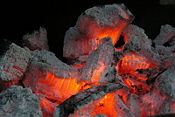Combustion: Difference between revisions
imported>Milton Beychok (Copy edit of the Table notes) |
imported>Milton Beychok m (→Adiabatic flame temperature: Another copy edit) |
||
| Line 120: | Line 120: | ||
* the stoichiometric [[air-fuel ratio]] <math>{\lambda}</math> | * the stoichiometric [[air-fuel ratio]] <math>{\lambda}</math> | ||
* the [[Specific heat|specific heat capacity]] of the fuel and the air | * the [[Specific heat|specific heat capacity]] of the fuel and the air | ||
* the air and fuel inlet temperatures | * the air and fuel inlet temperatures, as well as the relative humidity of the air | ||
The adiabatic flame temperature increases for higher heating values and for higher inlet air and fuel temperatures and for stoichiometric air-fuel ratios approaching one. | The adiabatic flame temperature increases for higher heating values and for higher inlet air and fuel temperatures and for stoichiometric air-fuel ratios approaching one. | ||
Revision as of 22:25, 12 March 2010
Combustion or burning is a complex sequence of exothermic chemical reactions between a fuel and an oxidant accompanied by the production of heat or both heat and light in the form of either a glow or flames. The most commonly used fuels are solid coal and hydrocarbon gases or liquids.
In complete combustion, a compound such as methane (CH4) reacts with an oxidizing element such as oxygen (O2) and the combustion products are compounds of each element in the fuel with the oxidizing element. For example:
CH4 + 2O2 → CO2 + 2H2O
A simpler example is the combustion of hydrogen (H2) and oxygen, which is a commonly used reaction in rocket engines:
2H2 + O2 → 2H2O
In the large majority of the real world uses of combustion, the oxygen oxidant is obtained from the ambient air. Taking air to contain 79 volume percent of non-combustible nitrogen (N2) and 21 volume percent oxygen, the resultant flue gas from the combustion of a fuel will contain nitrogen plus the products of combustion:
CH4 + 2O2 + 7.52N2 → CO2 + 2H2O + 7.52N2
As can be seen, when air is the source of the oxygen, nitrogen is by far the largest part of the resultant flue gas.
In reality, combustion processes are never perfect or complete. In the flue gases from the combustion of carbon (as in coal combustion) or carbon compounds (as in combustion of hydrocarbons, wood, etc.) both unburned carbon (as soot) and carbon compounds other than carbon dioxide such as carbon monoxide (CO) and others will be present. Also, when air is the oxidant, some nitrogen will be oxidized to various nitrogen oxides (NOx).
Types of combustion
Rapid
Rapid combustion is a form of combustion in which large amounts of heat and light energy are released, which often results in a fire. This is used in internal combustion engines and in thermobaric weapons. Sometimes, a large volume of gas is liberated in combustion besides the production of heat and light. The sudden evolution of large quantities of gas creates excessive pressure that produces a loud noise. Such a combustion is known as an explosion or detonation.
Slow
Slow combustion is a form of combustion which takes place at low temperatures. Cellular respiration is an example of slow combustion.
Turbulent
Turbulent combustion is a combustion characterized by turbulent flows. It is used for industrial applications such as gas turbines and diesel engines because the turbulence helps to mix the fuel and oxidizer.
Microgravity
Nearly every flame behaves differently in a microgravity environment. Microgravity combustion research contributes to understanding of spacecraft fire safety and diverse aspects of combustion physics.
Incomplete
Incomplete combustion occurs when there isn't enough oxygen to allow the fuel (usually a hydrocarbon) to react completely with the oxygen to produce carbon dioxide and water or when the combustion is quenched by a heat sink such as a solid surface or a flame trap.
The quality of combustion can be improved by the design of combustion devices such as furnace burners and internal combustion engines. Further improvements are achievable by catalytic after-burning devices or by the simple partial return of the exhaust gases into the combustion process. Such devices are required by environmental legislation for vehicles in most countries, and may be necessary in large combustion sources, such as the steam generating furnaces in thermal power plants, to reach legal emission standards.
Smouldering
Smouldering is a flameless form of combustion. The fundamental difference between smouldering and flaming combustion is that in smouldering, the oxidation occurs on the surface of a solid fuel rather than in the gas phase. The characteristic temperature and heat released during smouldering are low compared to those in flaming combustion (i.e., ~ 600°C vs. ~ 1500°C). Smouldering propagates in a creeping fashion, around 0.1 mm/s, which is about ten times slower than flames spread over a solid. In spite of its weak combustion characteristics, smouldering is a significant fire hazard.
Combustion with other oxidants
Oxygen is usually assumed as the oxidant when talking about combustion, but other oxidants exist. Nitrous oxide (NO) is used in rockets and in race cars. Fluorine (F2), another oxidizing element, can produce a combustion reaction that yields fluorinated products rather than oxides. For example, mixtures of gaseous fluorine and methane are explosive. Chlorine trifluoride is a strong fluorinating agent that ignites fuels more readily than oxygen.
Chemical equations
Generally, the chemical equation for stoichiometric burning of hydrocarbon in oxygen is as follows:
- CxHy + ( x + 0.25 y ) O2 → x CO2 + ( 0.50 y ) H2O
For example, the burning of propane is:
- C3H8 + 5 O2 → 3 CO2 + 4 H2O
The simple word equation for the combustion of a hydrocarbon in oxygen is:
- fuel + oxygen → carbon dioxide + water vapor
If the combustion takes place using air as the oxygen source, the nitrogen can be added to the equation, although it does not react, to show the composition of the flue gas:
- CxHy + ( x + 0.25 y ) O2 + 3.76 ( x + 0.25 y ) N2 → x CO2 + ( 0.50 y ) H2O + 3.76 ( x + 0.25 y ) N2
For example, the burning of propane in air is:
- C3H8 + 5 O2 + 18.8 N2 → 3 CO2 + 4 H2O + 18.8 N2
The simple word equation for the combustion of a hydrocarbon in air is:
- fuel + air → carbon dioxide + water + nitrogen
Nitrogen may also oxidize when there is an excess of oxygen. The reaction is thermodynamically favored only at high temperatures. Diesel engines are run with an excess of oxygen to combust small particles that tend to form with only a stoichiometric amount of oxygen, necessarily producing nitrogen oxide emissions.
Fuels
Liquid fuels
Combustion of a liquid fuel in an oxidizing atmosphere actually happens in the gas phase. It is the vapour that burns, not the liquid. Therefore, a liquid will normally catch fire only above a certain temperature, its flash point. The flash point of a liquid fuel is the lowest temperature at which it can form an ignitable mix with air. It is also the minimum temperature at which there is enough evaporated fuel in the air to start combustion.
Solid fuels
The act of combustion consists of three relatively distinct but overlapping phases:
- Preheating phase, when the unburned fuel is heated up to its flash point and then fire point. Flammable gases start being evolved in a process similar to dry distillation.
- Distillation phase or gaseous phase, when the mix of evolved flammable gases with oxygen is ignited. Energy is produced in the form of heat and light. Flames are often visible. Heat transfer from the combustion to the solid maintains the evolution of flammable vapors.
- Charcoal phase or solid phase, when the output of flammable gases from the material is too low for persistent presence of flame and the charred fuel does not burn rapidly anymore but just glows and later only smoulders.
| |||||||||||||||||||||||||||||||||
Adiabatic flame temperature
Assuming complete combustion under adiabatic conditions (i.e., no heat loss or gain), the adiabatic flame temperature can be calculated. The calculation is based on the first law of thermodynamics (i.e., the conservation of energy) and on the fact that the heat of combustion is used entirely for heating the fuel, the combustion air or oxygen, and the combustion product gases.[1][2]
In the case of fossil fuels burnt in air, the combustion temperature depends on:
- the heat of combustion (also referred to as the heating value)
- the stoichiometric air-fuel ratio
- the specific heat capacity of the fuel and the air
- the air and fuel inlet temperatures, as well as the relative humidity of the air
The adiabatic flame temperature increases for higher heating values and for higher inlet air and fuel temperatures and for stoichiometric air-fuel ratios approaching one.
Most commonly, the approximate adiabatic flame temperatures for coals are 2200 °C, 2150 °C for fuel oils and 2000 °C for natural gases. The adjacent table lists some calculated adiabatic flame temperatures for hydrogen and for various hydrocarbon gases, all at the conditions stated in the notes at the bottom of the table.
In industrial fired heaters, power plant steam generators, and large gas-fired turbines, the more common way of expressing the usage of more than the stoichiometric combustion air is percent excess combustion air. For example, excess combustion air of 15 percent means that 15 percent more than the required stoichiometric air is being used.
References
- ↑ Milton R.Beychok (2005). Fundamentals of Stack Gas Dispersion, 4th Edition. author-published, pp. 173-177. ISBN 0-9644588-0-2.
- ↑ Flame Temperature Professor Hsin Chu, National Cheng Kung University, Taiwan
General:
- Merle C. Potter and Craig W. Somerton (2006). Schaum's Outline of Thermodynamics for Engineers, 2nd Edition. McGraw-Hill. ISBN 0-07-146306-2.
- Steven S. Zumdahl (2003). Introductory Chemistry: A Foundation, 5th Edition. Brooks Cole. ISBN 0-618-30499-1.
- Warren C. Strahle (1993). An Introduction to Combustion, 1st Edition. ISBN 2-88124-608-7.


